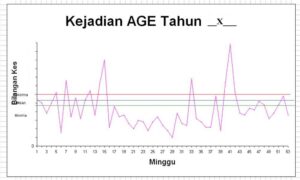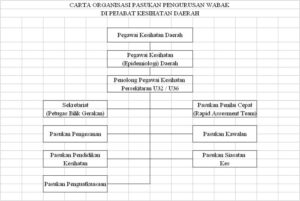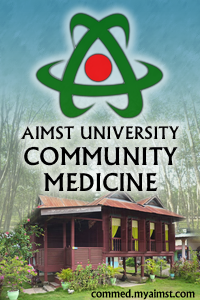Mr. Jamil, Penolong Pegawai Kesihatan Persekitaran, gave us the replacement talk on today. We just discussed about the overview of CDC,E-notis and outbreak investigation of food poisoning.
Mission: to prevent the communicable disease from occuring.
Objective of CDC:
- Reduce disease incidence and mortality from infectious diseases that it does not become a threat topublic health.
- Promoting a healthy lifestyle, appropriate preventive measures, detection and immediate treatment, ongoing monitoringand appropriate rehabilitation services.
- Encourage public participation while the cooperation of various agencies / sectors to create communityhealthy and caring.
Enforcement of the Acts: –
- Prevention and Control Act of Infectious Diseases 1988
- Destruction of Disease-Bearing Insects Act 1975 (Amendment 2000)
The jobs covered by CDC:
- Record for disease surveillance
- collect and analyse the data.
- investigate and detect the cause of the disease or contact person
- planning for disease control.
- take the speciment from suspected sample.
- prepare the report or written
- receive the order from higher authority ( State Health Officer)
Commonest Communicable Disease:
- Foodborne and waterborne diseases: AGE, cholera, leptospirosis
- Vector borne diseases:denggi fever, malaria, chikungunya
- Preventable communicable diseases by vaccination: typhoid, polio, tetanus
- Dry Cough: Tuberculosis, Leprosy
- Sexual Transmitted Diseases: syphilis, gonnorrhea
- HIV / AIDS
- Zoonotic Disease: plaque
- world wide disease
- New Diseases: H1N1, SARS
Disease Control: Kawalan Wabak (FWBD)
- Formation of Bilik Gerakan
- Formatin of Investigation Team
- Team of Disease control and Sanitation
- Health Education Team
CONTROL OF THE SPREAD OF INFECTIOUS DISEASE
Section 10. Requirement to notify infectious disease.
(1) Every adult occupant of any house in which any infectious disease appears, and every personin charge of, or in the company of, and every person not being a medical practitioner attendingon, any person suffering from or who has died of an infectious disease shall, upon becomingaware of the existence of such disease, with the least practicable delay notify the officer in chargeof the nearest district health office or government health facility or police station or notify thenearest village head of the existence of such disease.
(2) Every medical practitioner who treats or becomes aware of the existence of any infectiousdisease in any premises shall, with the least practicable delay, give notice of the existence of theinfectious disease to the nearest Medical Officer of Health in the form prescribed by regulationsmade under this Act.
(3) The person in charge of any boarding-house shall, with the least practicable delay, notify theofficer in charge of the nearest district health office or government health facility or police station ifhe knows or has reason to believe that any person in the boarding-house is suffering from or hasdied of an infectious disease.
(4) Any police officer or village head receiving notification under this section shall, with the leastpracticable delay, notify the officer in charge of the nearest district health office or governmenthealth facility.
(5) Any person who contravenes this section commits an offence.
(6) When any person is charged under this section, he shall be presumed to have known of theexistence of the infectious disease or to have had reason to believe that an infectious diseaseexisted, unless he shows to the satisfaction of the Court before which he is charged that he didnot know and could not with reasonable diligence have obtained knowledge of the infectiousdisease or that he did not have reason to believe that an infectious disease existed.
Notification of Diseases by telephone and followed by Notification of disease in the written form:
- Dengue Fever or DHF
- Yellow Fever
- Diphtheria
- Ebola
- Food Poisoning
- Cholera
- Plaque
- Poliomyelitis
- Rabies
* for Chikungunya, notification is same as Dengue Fever
Notification of Diseases in written form within 1 week of duration after diagnosis:
- Whooping cough
- Measles
- Chanchroid
- Dysenteries (all form)
- Gonoccocal infection (all form)
- Leprosy
- Malaria
- hand, FOot & Mouth Disease.
- Relapsing Fever
- syphilis (all forms)
- Tetanus (all forms)
- Typhoid & paratyphoid fevers
- typhus & other ricketsioses
- Tuberculosis
- Ciral encephalitis
- Viral Hepatitis
- Any other life threantening microbial infection
- HIV (all forms)
(Example of the graph)- number of cases cannot be published as it is P&C)
Green line shows the median. If the number of cases exceed more the red line ( 75percentile), something is going wrong right there. ExampleL week 15, 33, 42.. Action should be taken to investigate the cause.
OUTBREAK OF FOOD POISONING
General Definition: sudden onset of vomiting, diarrhea and other symptoms that are caused by food or drink.
Outbreak Definition: 2 or more cases which poses similiar symptoms after eating the same food or different type of food in a same food premise/ place.
Organization Cart:
Step of Investigation in Outbreak of Food Poisoning:
- Confirm the cases: by disease notification according to district E-notis.
- Form a team of outbreak investigation.
- obtain the sample from the suspected spot: usually, there is nothing could be found because the food premise owner would have clean the spot before health officer team reach.
- Implementing the steps of disease control and prevention
- collect all the information related to the outbreak. Health officer will ask all the patients what they had eaten, type of food, duration. At the same time, another control sample with similar constant varible (2 – 5 times of the affected patients in the outbreak).E.g Outbreak of food poisoning in the school. 25 students are affected. 50-100 control sample from health students are selected.
- Develop the hypothesis
- Plan and investigated the epidemiological data: Odd ratio, attributary risk
- analyze the data
- Inteprete the data and make the conclusion
- Make the record.
• Ordinary – FWBD/KRM/BG/001 Pind 2008
• Complex – FWBD/KRM/BG/001 Pind 2008 & Scientific Write up
Question to be asked during outbreak of Food Poisoning.
From the above statement, attributable risk is much more higher.
Odd ratio shows Nasi Goreng is the most probably food that cause food poisoing.
According to Mr. Jamil, Nasi Goreng and Ayam Goreng are the 2 commonest food that cause food poisoning not only in the Sik, but whole Malaysia. The affected place are usually school canteen and hostel.
Lastly, Mr. Jamil show us the E-notis. Due to private and confidential, the content is not allowed to post in here. Here is the link to E-notis: http://enotis.moh.gov.my/ . For the user account of PPKP of CDC, SIK, only information of patients from SIK is available; similarly, user account of State Health Officer will be able to access patients information from that particular state only. Once log in E-Notis, number of cases of that week and number of cases in the year will be appeared.
Data of that particular patient such as IC number, address, date of admission, hospital name…. will be key in in the E-notis.It serves as a two-way communication tool, i.e. data flow from peripheral to center as well as from center to peripheral..If the case appears come from other district, for example, a patient from Kubang Pasu come to Hospital in Sungai Petani. Penolong Pegawai Kesihatan Persekitaran will key in the data and transfer the case to the E-notis of Kubang Pasu, not Kuala Muda. The information will be available to Kubang Pasu DHO and appropriate actions will be carried out. Conversely, if a disease is diagnosed at a DHO, the data entry is to be done by the DHO and available to the state as well as central level. However, this is rare because only confirmed cases will be entered into the system and confirmation normally done by laboratories in larger centers.
By using E-notis, number of cases per year (or any duration) could be sorted out in a table.The officers in charge are expected to keep themselves updated daily by logging in everyday. E-notis enables real time information sharing and make the notification process faster and easier. It is a very useful programme to evaluate the Communicable disease in the district.
By Jun Sian
Source: mbbs12sik.blogspot.com






